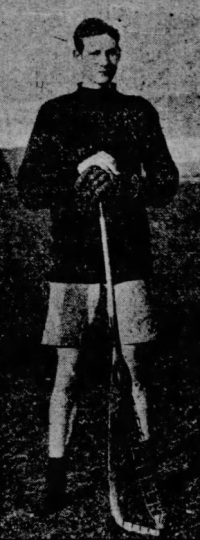
VICTOR GORDON ‘DODE’ SINCLAIR
(July 18, 1898 – June 22, 1958)
New Westminster Salmonbellies (1920; 1922)
Long Beach (1924)
Victor Gordon Sinclair – better known in New Westminster sporting circles by his nickname ‘Dode’ Sinclair – was born on Mayne Island, British Columbia in 1898. His parents were James William Sinclair and Annie Isabel Irving. His father was born in Washington Territory and had moved to New Westminster in 1875, becoming a teacher in the Fraser Valley school district for twenty-five years, then later employed on steamboats and finally the British Columbia Electric Railway as an accountant.
Young Gordon moved to New Westminster at a very early age and in his youth he played on the John Robson Elementary School lacrosse team in 1913. Along with lacrosse, he was also known in the Royal City as an amateur basketball and football player.
His older brother was Irving Sinclair [1893-1969], who became famous as one of San Francisco’s best-known commercial artists from the mid-1920s into the 1960s. ‘Dode’ also had five sisters, two of whom ended up marrying the brothers George and Tom Rennie, of New Westminster Salmonbellies fame from a decade or so prior. Sinclair’s own wife Edna was the sister of team-mate Laurie Nelson. When Sinclair joined the professional Salmonbellies in 1920, he found himself team-mates with two of his brother-in-laws, Laurie and George – in what was Dode’s rookie season as a professional while George Rennie was making his final curtain-call after a 20-year career.
‘Dode’ served in the Canadian military during the Great War, and in October 1917 Private Sinclair was awarded the Military Medal for gallant conduct as a battalion runner on the front lines with the 47th Battalion. He had been serving at the front lines for several months and during combat near Lens in France, his company had come under fire and every sergeant was killed in the fighting, with the sergeant-major and two officers wounded and put out of action. Sinclair and one other soldier were the only remaining runners after four other runners had either been killed, wounded by snipers, or incapacitated by shell shock. Along with the medal and ribbon, he received a letter of commendation from the company’s brigadier general.
Sinclair signed with the professional New Westminster outfit in July 1920 and it immediately caused a major rift with the Royal City amateurs, as the pros had been raiding the amateur side that year for new blood. George Feeney and Harold ‘Haddie’ Stoddart had already been scooped by Manager Tom Gifford – and when Sinclair then backpedaled his commitment to the amateurs and jumped to the pros, the fortunes of the amateur Salmonbellies in their pursuit of the Mann Cup were put in some serious doubt. At the time of his departure from the amateur squad, Sinclair had been tied second on the goal-scoring list for the Pacific Coast Amateur Lacrosse Association, and second-place for his team.

He missed out the 1921 season when he found himself stuck in Australia due to a shipping strike which prevented him finding passage back home. Sinclair returned for the 1922 season but did not seem to have the impact or promise he had shown in 1920. His short professional career of two seasons spanned 25 games and he chalked up 3 goals to his name, from playing in almost all matches as a substitute and a half-dozen starts.
Sinclair left New Westminster in 1923 and began working in California when he gained employment sinking oil wells for Standard Oil and this proved more profitable than what his lacrosse career could ever provide. The following year or so he owned and operated an appliance store in Los Angeles. Then around 1942 he made a career change once more and became an orchard farmer, running an orange grove in Los Angeles County prior to acquiring his own grove, a year prior to his death, in the city of Exeter in Tulare County.
Despite departing the lacrosse hot-bed of British Columbia for greener pastures down south, he never forgot his old love for the game. In 1924, along with his brother-in-law Tom Rennie and ex-Vancouver pro Charlie ‘Smiler’ McCuaig, they helped introduce lacrosse in the Long Beach area and a 1924 lacrosse championship was played between Long Beach and Los Angeles Canadian-Californian teams. In 1938 when the Pacific Coast Lacrosse Association started play in Southern California and raided the Canadian box leagues for players, ‘Dode’ Sinclair became the manager for the Los Angeles Canucks entry in the four-team league, which was made up of star-players from the New Westminster Adanacs and a sprinkling of Richmond Farmers and Vancouver Burrards talent. The PCLA lasted around a month before it folded in mid-season after games on January 29, 1939 due to poor arena conditions.
Victor Gordon Sinclair passed away on June 22, 1958 at his home located southeast of Exeter, California. He was survived by his wife Edna but there is no mention of any surviving children in his obituaries. While long-forgotten today as one of the many obscure, fringe players who have come and gone throughout the sport’s history, ‘Dode’ Sinclair’s short career is proof enough that all players great and not-so-great, superstar or bench-warming substitute, all have stories to tell from their lives lived.
(PHOTO SOURCES: Vancouver Province October 16, 1917; Vancouver Sun April 11, 1922)






You must be logged in to post a comment.